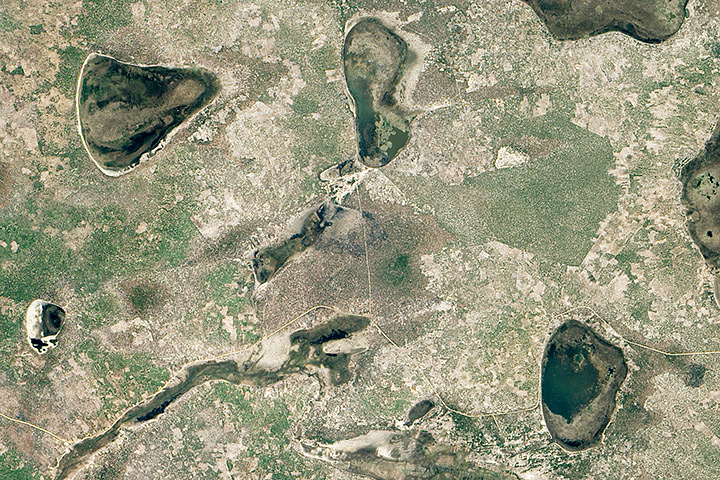Each month, Earth Observatory offers up a puzzling satellite image here on Earth Matters. In celebration of Earth Month 2013, we’re upping the ante. We are going to release a new puzzler image every day this week. The fourth image is above. Your challenge is to use the comments section to tell us what part of the world we are looking at, when the image was acquired, and why the scene is interesting. We’ll post the answer to all five puzzlers at 6 p.m. EST on Friday, April 26.
How to answer. Your answer can be a few words or several paragraphs. (Try to keep it shorter than 200 words). You might simply tell us what part of the world an image shows. Or you can dig deeper and explain what satellite and instrument produced the image, what spectral bands were used to create it, or what is compelling about some obscure speck in the far corner of an image. If you think something is interesting or noteworthy, tell us about it.
The prize. We can’t offer prizes, but we can promise you credit and glory (well, maybe just credit). Later this week when we post annotated and captioned versions of the puzzler images as our Image of the Day, we will acknowledge the people who were first to correctly ID the images. We’ll also recognize people who offer the most interesting tidbits of information. Please include your preferred name or alias with your comment. If you work for an institution that you want us to recognize, please mention that as well.
Recent winners. If you’ve won the puzzler in the last few months, look at this week as a new challenge — can you get all five image locations?
Good luck!





-Dolinas, formaciones Karsticas provocadas por la erosión sobre roca, principalmente caliza.
-Se perciben rasgos antropoformicos, como son caminos y limitaciones de vegetación por cultivos.
-México o India.
i dont understand what kind of this image, it look like foot of dinosour.. lol
karst formations from the erosion of limestone and gypsum in the area just to the northeast of Lake Okeechobee in central Florida
This image is from Michigan, USA. It is supposedly images of Pul Bunion’s foot prints.
ES YUCATAN, MEXICO
sink holes caused by collapsing salt domes
NOT LOOKING 4 U BUT SAW PICT…LOKKS LIKE AN ‘ARID’ GOLF COURSE!
I’m going to go with Alberta oil sands. A grim image for Earth Day, but that’s what it reminds me of.
The lakes could also be small kettle lakes left over from ancient glaciation in the area, they appear to be partially dry, so timing would be late summer or what ever the dry season in the region is.
This is melting ice-sheet in the Arctic in Canada or Russia, probably Siberia. Water from the melting ice is pooled in the depressions in the ground. These depressions probably are permanent lakes and the melt has swelled them. The pale lines that run along the edges of the lakes are roads and they generally follow the low-lying areas. The irregularly shaped, sharp edged jigsaw piece-like patterns are the ice patches on the higher ground and the rest of the land, which is low-lying, has been freed from the ice sheet.
The everglades in Florida
Chicxulub asteroid impact outer rings, with the “wells” around.
sinkholes in africa from uranium deposits
Limestone cavern collapse over a wide area of coral deposits with high water table. So perhaps Florida, but the interesting thing is the timing. This view is of land likely to be flooded by sea rise as present extinction event proceeds. http://arctic-news.blogspot.com/2013/04/another-link-between-co2-and-mass-extinction-of-species.html It is unlikely coral will be able to survive as well as any life at all. So considering rate of runaway global warming and size of land based ice available for melt this view could easily be open ocean by 2100.
The coral survived the worst previous extinction event at end of Permian I think but with new form with six sides instead of eight but this time will be different. Forcing is so large from man’s use of fossil fuel and supply of methane so large due to shape of Arctic Ocean where shallow edges let methane hydrate ice grow so long that the pall of gas forcing down on the surface will ignite a full blown moist runaway shift of type M planet out of HZ.
Somewhere is west-central Asia, southern Russia? around the Aral sea, the lighter colored patches appear to be somewhat square (maybe rhomboid?) indicating agriculture that is no longer viable. Combined with the drying lakes (the older, larger lake boundaries are visible), this indicates an area with persistent drought. However, this general region has literally 1000’s of small lakes, can’t pin point it.
I think the visible light satellite image represents a limestone country,especially what is called a ‘Karst Scenery’The rounded or ovoid features visible on this photo are most likely depressions in karst landscapes called Dolines or Swallow holes.I am not sure about the specific location of the scenery but my guess would be somewhere in South America.
Nazca, Peru?
Myakka River State Park in florida